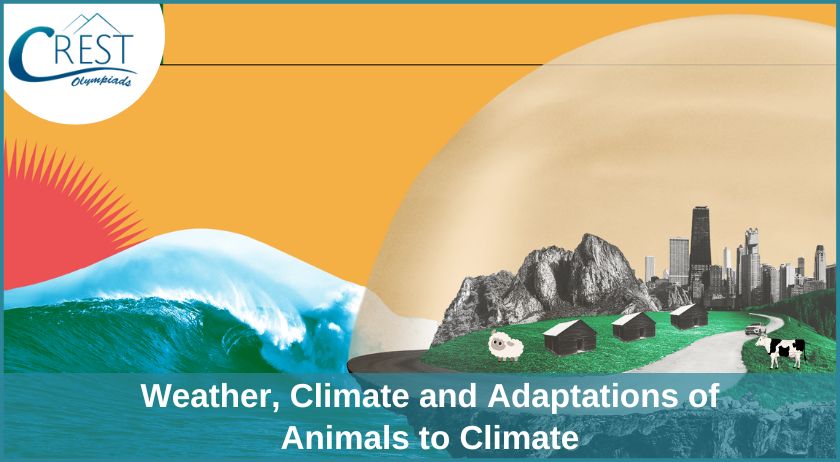Weather Climate and Adaptations of Animals to Climate is chapter 7 in the NCERT class 7 Science book. Our prepared notes for this chapter are unquestionably helpful for students preparing for the CREST Science Olympiad (CSO) for class 7 and similar competitions. Students can rely on these notes for excelling in their regular school tests as well.
Class 7 Science chapter 7 notes provided here will enable students to quickly review the topic with a clear understanding. These notes, which are specifically created for the class 7 weather climate and adaptation, are written in a clear, understandable and condensed style that helps students to learn all the topics covered in this chapter before the exam swiftly.
Class 7 Science Chapter 7 pdf is also available to download for free to make it easier for students to revise the concepts later.
Class 7 Notes for Chapter - Weather Climate and Adaptations of Animals to Climate.
Weather, Climate and Adaptation
Weather
The day-to-day condition of atmosphere in a particular region is called weather. It may be pleasant weather or it may be too hot or cold.
Weather Report
The daily report about weather; usually released by the meteorological department is called weather report. On television, the weather report is frequently broadcast with the news.
Elements of weather
The various elements of weather are: temperature, humidity, rainfall, wind speed, etc.
Temperature
Temperature depends upon the duration of sunshine. During the summer season, the duration of the sunshine is longer. As a result, the temperature is high in summer. Temperature is minimum in the morning while temperature is highest at noon.
Humidity
Humidity is the amount of moisture present in air. Humidity is generally measured in percentage. Humidity is generally at its highest level; during the rainy season.
Rainfall
The amount of rainfall is measured in terms of mm. For this, an apparatus; called a rain gauge is used.
Wind speed
The speed of wind also affects the condition of the weather.
Department of Meteorology
This is a Government Department. The Meteorological Department measures the elements of weather and keeps their record. Weather predictions are made by meteorologists using satellite data that has been analyzed.
Climate
Climate refers to the long-term pattern of weather in a particular area. Typical weather patterns for at least 25 years in a specific geographic area refers to the climate of that area.
India's climate is described as being hot and humid because most of the year, both the temperature and humidity are typically high. Because of the high temperature in Rajasthan, the climate is said to be hot and dry whereas humidity is very low. However, due to the low temperature, the climate of Kashmir is said to be cold.
Rainforest
Rainforest is found generally near the equator. Places near the equator receive more sunshine and hence more rainfall. This makes the place hot and humid. Generally, near the equator, temperatures vary from 15?C to 40?C. In some tropical areas, Rainforests are also present.
Desert
Temperature in the desert is generally higher and it receives less or little rainfall. So, deserts are hot and dry.
Polar Region
Polar Region is at high latitude and hence does not receive adequate sunshine. Due to this, in the Polar Regions temperature is very low. And because of the low temperature, Polar Region is covered with snow.
Climate and Adaptation
In several places, such as deserts, polar regions, etc. climate is very harsh. Many organisms live and thrive in these places, in spite of the harsh climate. Living in such environments causes animals and plants to evolve certain traits that help in surviving the harsh climate. Adaptation is known as the feature of developing in order to survive a given climate.
Adaptation in Polar Region
In Polar Regions, the sun does not set for about six months and also does not appear for the next six months of the year. For the most part of the year, these regions are covered with snow. In winter, the temperature may down to -37°C. Thus, the climate of Polar Regions becomes extreme and harsh to survive. In spite of such conditions, many animals live in those places, for example, Polar Bear, Penguin, Snow Leopard, etc. These animals exhibit a variety of adaptations that enable them to survive in the harsh climate of the Polar Region.
Polar Bear
- On its body, there are two thick layers of fur and a thick layer of fat under the skin; called blubber. These layers act as insulators and prevent the bear from extreme cold. Because of the white fur, it becomes easy for the Polar Bear to hide from its prey and predator as he can easily get mixed with the snowy background. Getting hide with surrounding because of special colours and patterns is known as camouflage.
- The long, curved nails on the wide paws of polar bears are called claws. This helps them to move on the snow and swim to keep them cool. Wide paws work as a rudder while swimming. They are very good swimmers.
- A polar bear has a highly developed sense of smell which helps him to find a fish even from under a thick layer of snow.
These adaptations enable the Polar Region to adapt to its harsh environment.
Penguin
- Penguins also live in the Polar Region. Penguins are white in colour with black backs.
- A thick layer of fat is also present beneath their skin. This protects them from extreme cold.
- They usually remain huddled together. This keeps them warm, and their curved claws make it easier for them to walk through snow and swim in the water.
- The penguin can survive in the harsh conditions of the Polar Region because of these adaptations.
Birds
- There are various types of birds found in Polar Regions. They fly to warm regions during winter to survive. In search of favourable climates, they travel very far and cover a long distance which is called migration.
- Some migratory birds are known to travel as long as 15000 km to keep them surviving in opposite climatic conditions. The Arctic tern is known to be the longest traveller among migratory birds.
Apart from birds, many fishes and mammals also migrate to different places in a search of favourable climate conditions.
Tropical Rainforest
The Western Ghats and Assam in India are home to tropical rainforests. Southeast Asia, Central America, and Central Africa are other regions with rainforests.
The plenty of food in rainforests supports a wide variety of species. The rainforests are home to a variety of species, e.g. leopards, elephants, snakes, tigers, monkeys, buffaloes, frogs, apes, lizards, many types of birds, insects, etc.
Despite having plenty of food, animals in the rainforest compete fiercely to survive.
Adaptive features of animals found in the rainforest
Lion
- The lion's colour makes it easier to get blend with its surroundings.
- Lion also has a highly developed sense of smell and night vision. All of these features help lions to catch their prey easily.
Elephant
- Elephants have a well-developed sense of smell. It helps the elephant in finding food. Its trunk has powerful muscles which help in uprooting even a big tree.
- Elephants have a good sense of hearing which helps the elephant in sensing danger way in advance.
- An elephant uses its trunk to sprinkle water all over its body to reduce its body temperature.
Monkeys
- Monkeys are highly adapted to living in rainforests. Monkeys can hang and swing from a branch by grasping it with their palms and soles. It might use its tail to hold a branch in place.
- Monkeys can see clearly in the wild because they can climb to the tallest branch of a tree. This helps them in sensing danger and also in finding food.
Frogs
- Frogs are able to survive in both water and on land.
- The frog's greenish colour makes it easier for it to blend in with the surrounding greenery. A frog can catch its prey with its lengthy, sticky tongue.
- The red-eyed frog lives on trees in tropical rainforests. They have sticky pads on their feet that help them to climb trees. It does not live in water and has a green back and a creamy underside. It has big and bulging bright-red eyes and it is nocturnal. It sleeps during the day and becomes active during the night and feeds on the insects present on the tree. Its bulging eye protects it from its predator. The sudden opening of big and bright-red eyes frightens the predator for a while and in the meantime, the frog gets time to jump to a safe place. Its green colour helps it to hide within the green leaves of the tree and helps it to protect itself from predators.
Important Points
Weather: Day-to-day atmospheric conditions.
Climate: Average of the atmosphere for at least 25 years.
Elements of weather: Temperature, Humidity, Rainfall, Wind-speed, etc.
Rainforest: Dense forest near the equator and tropical regions.
Desert: A desert area with high temperatures, limited rainfall, and full of sand. Polar Regions: Regions near poles, having very low temperatures, the area is covered with snow most parts of the year.
Adaptation: Special habits of animals that enable them to survive in particular climatic conditions.
Camouflage: Special colour of animals because which they can resemble a background of surroundings that hides from predators.
Class 7 Notes PDF for Chapter - Weather Climate and Adaptations of Animals to Climate
When content is simple to understand and approachable, learning becomes simple. With the provided notes pdf listed below, interested students can confidently prepare for the CREST Science Olympiad (CSO) and many more exams of a similar nature. Click on the below link to download the free pdf for class 7 Science chapter 7.Download Notes PDF for Weather Climate and Adaptations of Animals to Climate
CREST Science Workbooks
As extra information, more resources are also available for students to practice hard. Students are encouraged to think about using CREST Olympiads workbooks, which are created specifically to assist students in measuring and enhancing their preparation for Olympiad exams.
Although the students have got sufficient clarification about Weather Climate and Adaptation till far but for more detailed reading material, students can purchase CREST Science workbook for class 7 which includes detailed explanations of each topic as well as practice questions with answer key. The book also includes class 7 previous year paper of the CREST Science Olympiad. The book is appropriate for preparing students for CREST Science Olympiad (CSO) and other competitive exams. Also, for regular school studies, this book can also be referred to.
Proceed now to purchase Olympiad books.
Useful Links
CREST Science Olympiad Book (First Chapter) PDF for Class 7 (Free Download)
CREST Olympiads Books for Class 7
Conclusion
Hopefully, this would have helped students to understand Weather, Climate and Adaptation for class 7. We did our best to provide notes for chapter 7 of class 7 Science. We have tried to cover all topics of the chapter in this pdf. We would love to continue providing more information on Science topics to students in the future.








